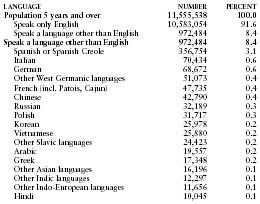Pennsylvania
Languages
Once home to several Algonkian tribes, Pennsylvania still has such Algonkian place-names as Punxsutawney, Aliquippa, Pocono, Towanda, Susquehanna, and Shamokin. An Iroquoian tribe gave its name to the Conestoga region. The word came to identify first the pioneers' covered wagons manufactured in the area and then, in shortened form, a cheap cigar called a stogie.
Although not quite homogeneous, Pennsylvania's North Midland dialect is significant as the source of much midwestern and western speech. The only non-Midland sector is the northern tier of counties, settled from southern New York State, where features of the northern dialect predominate.
On the whole, Pennsylvania North Midland is distinguished by the presence of want off a tram or bus, snake feeder (dragonfly), run (small stream), waterspouts and spouts (gutters), and creek as / krik/. With these features are found others that commonly occur in Southern Pennsylvania, such as corn pone, roasting ears, and spiket (spigot). Western Pennsylvania, however, contrasts with the eastern half by the dominance of /nawthing/ for nothing, / greezy/ for greasy, /kao/ for cow, sugar tree (sugar maple), hap (quilt), and clothes press (closet), as well as by the influential merging of the /ah/ vowel and the /aw/ vowel so that cot and caught sound alike. Southern Pennsylvania has flannel cakes for pancakes and ground hackie for chipmunk. Within this region, Philadelphia and its suburbs have distinctive baby coach for baby carriage, pavement for sidewalk, hoagie for a large sandwich, the vowel of put in broom and Cooper, and the vowel of father in on and fog. In the east and northeast, a doughnut is a cruller, one is sick in the stomach, and syrup has the vowel of sit.
In much of central Pennsylvania, descendants of the colonial Palatinate German population retain their speech as Deutsch, often misnamed Pennsylvania Dutch, which has influenced English in the state through such loanwords as toot (bag), rainworm (earthworm), snits (dried apples), and smearcase (cottage cheese).
In 2000, 10,583,054 Pennsylvanians—91.6% of the population five years old or older—spoke only English at home, down slightly from 92.7% in 1990.
The following table gives selected statistics from the 2000 census for language spoken at home by persons five years old and over. The category "Other West Germanic languages" includes Dutch, Pennsylvania Dutch, and Afrikaans. The category "Other Slavic languages" includes Czech, Slovak, and Ukrainian. The category "Other Asian languages" includes Dravidian languages, Malayalam, Telugu, Tamil, and Turkish. The category "Other Indic languages" includes Bengali, Marathi, Punjabi, and Romany. The category "Other Indo-European languages" includes Albanian, Gaelic, Lithuanian, and Rumanian.

| LANGUAGE | NUMBER | PERCENT |
| Population 5 years and over | 11,555,538 | 100.0 |
| Speak only English | 10,583,054 | 91.6 |
| Speak a language other than English | 972,484 | 8.4 |
| Speak a language other than English | 972,484 | 8.4 |
| Spanish or Spanish Creole | 356,754 | 3.1 |
| Italian | 70,434 | 0.6 |
| German | 68,672 | 0.6 |
| Other West Germanic languages | 51,073 | 0.4 |
| French (incl. Patois, Cajun) | 47,735 | 0.4 |
| Chinese | 42,790 | 0.4 |
| Russian | 32,189 | 0.3 |
| Polish | 31,717 | 0.3 |
| Korean | 25,978 | 0.2 |
| Vietnamese | 25,880 | 0.2 |
| Other Slavic languages | 24,423 | 0.2 |
| Arabic | 19,557 | 0.2 |
| Greek | 17,348 | 0.2 |
| Other Asian languages | 16,196 | 0.1 |
| Other Indic languages | 12,297 | 0.1 |
| Other Indo-European languages | 11,656 | 0.1 |
| Hindi | 10,045 | 0.1 |